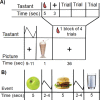Relation of FTO to BOLD response to receipt and anticipated receipt of food and monetary reward, food images, and weight gain in healthy weight adolescents
- PMID: 31680145
- PMCID: PMC7657457
- DOI: 10.1093/scan/nsz081
Relation of FTO to BOLD response to receipt and anticipated receipt of food and monetary reward, food images, and weight gain in healthy weight adolescents
Abstract
Although the fat mass and obesity-associated gene (FTO) correlates with elevated body mass, it is unclear how it contributes to overeating. We tested if individuals with the A allele show greater reward region responsivity to receipt and anticipated receipt of food and money and palatable food images. We also tested if these individuals show greater future weight gain. Initially healthy weight adolescents (Study 1, N = 162; Study 2, N = 135) completed different functional magnetic resonance imaging paradigms and had their body mass measured annually over 3 years. Adolescents with the AA or AT genotypes showed less precuneus and superior parietal lobe response and greater cuneus and prefrontal cortex response to milkshake receipt and less putamen response to anticipated milkshake receipt than those with the TT genotype in separate analyses of each sample. Groups did not differ in response to palatable food images, and receipt and anticipated receipt of money, or in weight gain over 3-year follow-up. Results suggest that initially healthy weight adolescents with vs without the FTO A allele show differential responsivity to receipt and anticipated receipt of food but do not differ in neural response to palatable food images and monetary reward and do not show greater future weight gain.
Keywords: FTO gene; BOLD response; adolescents; prospective; weight gain.
© The Author(s) 2019. Published by Oxford University Press.
Figures



References
-
- Berkey C.S., Colditz G.A. (2007). Adiposity in adolescents: change in actual BMI works better than change in BMI z score for longitudinal studies. Annals of Epidemiology, 17(1), 44–50. - PubMed
-
- Cavanna A.E., Trimble M.R. (2006). The precuneus: a review of its functional anatomy and behavioural correlates. Brain, 129(Pt 3), 564–83. - PubMed
-
- Cecil J.E., Tavendale R., Watt P., Hetherington M.M., Palmer C.N. (2008). An obesity-associated FTO gene variant and increased energy intake in children. The New England Journal of Medicine, 359(24), 2558–66. - PubMed

